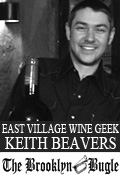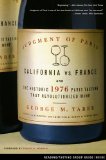 The East Village Wine Geek Keith Beavers is the owner of In Vino [215 East 4th Street, Manhattan] as well as The Alphabet City Wine Company [100 Avenue C, Manhattan]. He’s one of the colorful and passionate columnists featured in The Brooklyn Bugle… coming soon.
The East Village Wine Geek Keith Beavers is the owner of In Vino [215 East 4th Street, Manhattan] as well as The Alphabet City Wine Company [100 Avenue C, Manhattan]. He’s one of the colorful and passionate columnists featured in The Brooklyn Bugle… coming soon.
Here’s a sneak preview…
I am going to start this one with a recent quote from the San Francisco Chronicle:
[It all started] when Hanzell Vineyards imported new French oak barrels, wineries mimicked the way wine was made in Chardonnay’s old home of Burgundy. The key components- oak, plus stirring the lees to add body, plus unhindered malolactic fermentation to soften the texture-were a hit…just one problem: These methods were intended for the finest, most low-yielding grapes. Most fruit wasn’t so good.
This, “is what winemaker Kevin Kelley calls a ‘perfect storm’.”
We might as well begin with what we know — the nasty over oaked buttery Chardonnay that people are shunning these days. Then after we understand how it got to this point in North America I will wind my researching ways around the world in search for origins and distinguishing methods.
European vines traveled to California in the mid 19th century. As the Gold Rush hit more and more people were heading to the Golden State. Among them were wine makers. So much that by prohibition, there were about 700 wineries in Cali alone (this number wasn’t matched until the 1990’s).
Chardonnay came to California in the 1930’s but wasn’t thought about much. It is hard to believe that such a malleable variety was so unknown in a burgeoning region. Even in the 1960’s it was listed a miscellaneous grape. But not for long.
It started in the 1950’s with a man named James Zellerbach of Hanzell Winery. He was in love with the wines of Burgundy and felt he could emulate that style in California. He proceeded to import the first French oak barrels to the U.S. and employ the exact methods used in Burgundy with Pinot Noir and Chardonnay. The result laid the foundation for what we are experiencing today: toasty, buttery, vanilla-laden, deep, golden chardonnay meant for longevity. At the time, his yields were low and his methods exact which brought complexity.
People went a bit nuts.
This was the new way to make wine and especially Chardonnay. After a couple of mentions in California wine literature and in other media winemakers began to mimic the practices of Mr. Zellerbach. The problem was not all were in the same area as him or had the same clones as him or the strict discipline. This means that the methods were the same but the fruit was not nor in most cases the climate.
Chardonnay is pretty tough in the winery allowing for great experimentation but in the vineyard it is an early ripening grape. If it is not picked at the right time it will rapidly loose its acidity and have way too much natural sugar resulting in high alcohol and loss of complexity. If it is not pruned well and doesn’t see any canopy management (techniques used to optimize light exposure and air circulation aiding in a gradual and even ripening process–we want the grapes to be happy and give good, balanced fruit) the vine can’t compete for nutrients and the result is weaker wine with no real character (not mentioning names but it rhymes with Rendall Hackson).

This trend of “Burgundian Style,” ran rampant through the 1960’s and into the 1970’s. In 1976, something big happened. It was something that would change the wine culture of California forever as well as Chardonnay: the Judgment of Paris. This was a casual challenge in a wine shop in Paris pitting French and California wine against each other in a blind tasting to see whose was better. There happened to be a journalist, George Taber
, present. To his surprise, the California wine won first place in a number of categories (including Chardonnay) compelling him to write a story about it creating a watershed moment in California wine.
The winning white wine was a chardonnay made in California in the Burgundian Style made by a man named Mike Grgich. After this it was all over. The world was stunned to find that California wines were at the top of the mount vino sharing the spotlight with some of the most respected French wineries in the world and craze followed suit.
By the 1980’s there were more chardonnay vines planted in the state of California than in all of France. By 2005 there were 100,000 acres of what we now refer to as chard in the state.
What happened between the late 80’s and 2005? Glut. It was all the rage to drink over sweet, toasty, buttery, overwhelming Chardonnay in the United States. Americans were still trying to figure out how to buy and appreciate wine and they were being told this was it. They were told that this style of chardonnay was reminiscent of the wines from the cool hills of Burgundy. This was not the case. We had taken a wonderful and time-tested method and rushed it into production not taking into account restraint and subtlety.
As a result the nineties were all about bad chardonnay and the grape started to gain the momentum of mockery. In the late 1990’s an acronym surfaced as people’s palates were fatigued by the over alcoholic cult style golden vanilla banana boat: ABC (Anything But Chardonnay).
And here we are today. But there’s hope on the horizon and a light at the end of the tunnel.
Today we are seeing a new regime of Chardonnay on the market. No-oak Chards are all over the place and showing even more of what this wonderful grape has to offer. There is so much deep concentration of minerality and citrus fruit when no oak has been exposed to Chard that it takes on a new personality. And if we enjoy this new approach we have a better sense of where it all started and where it has come.


